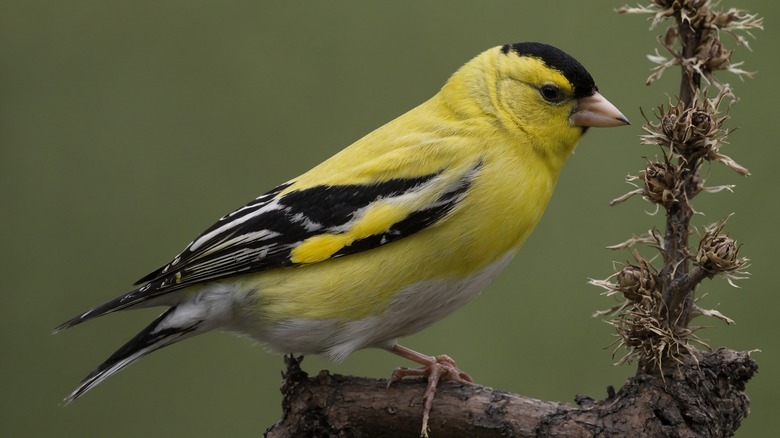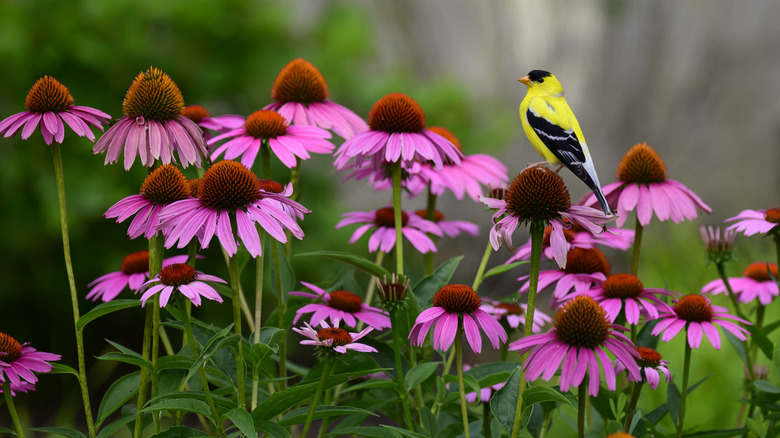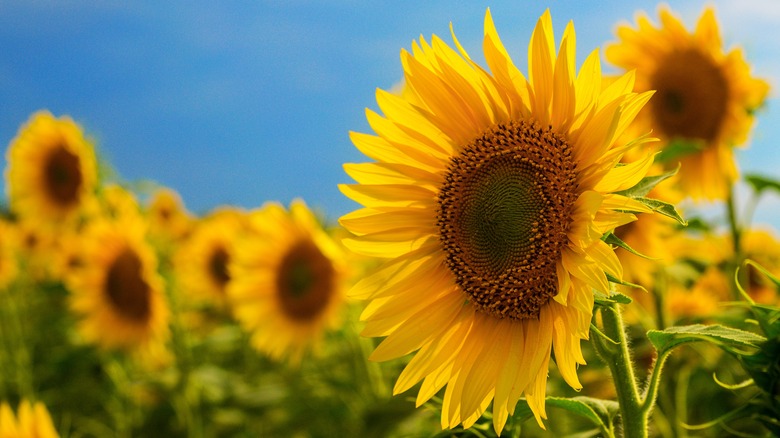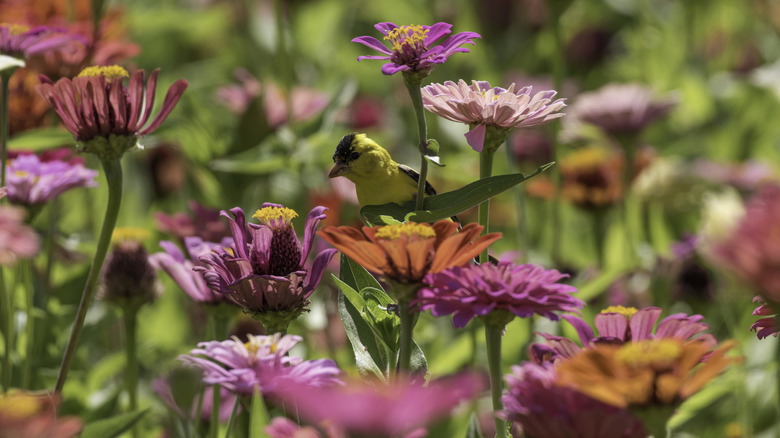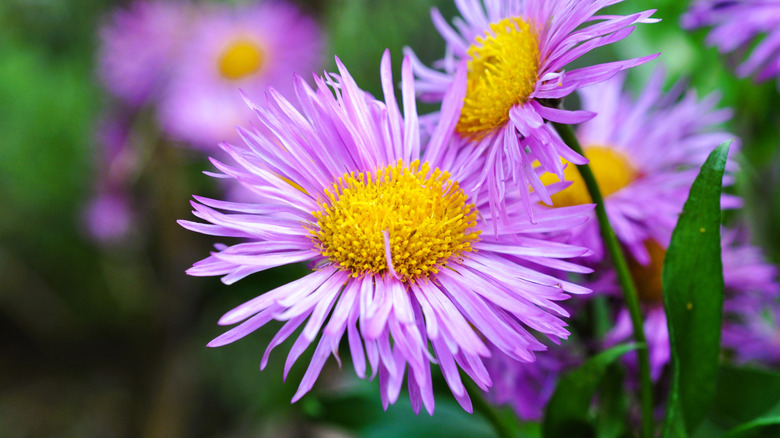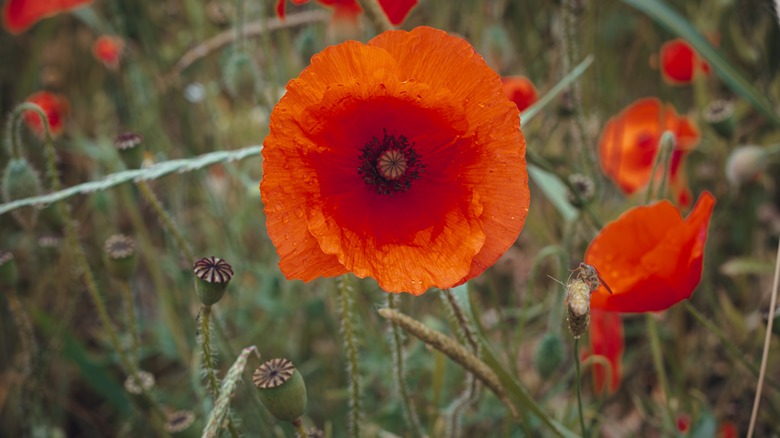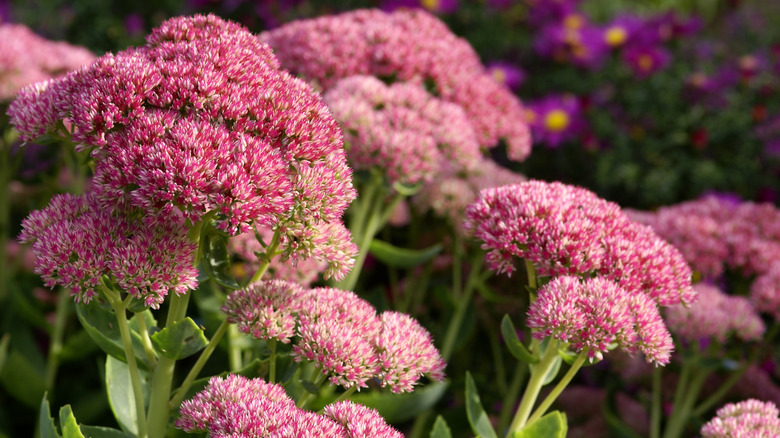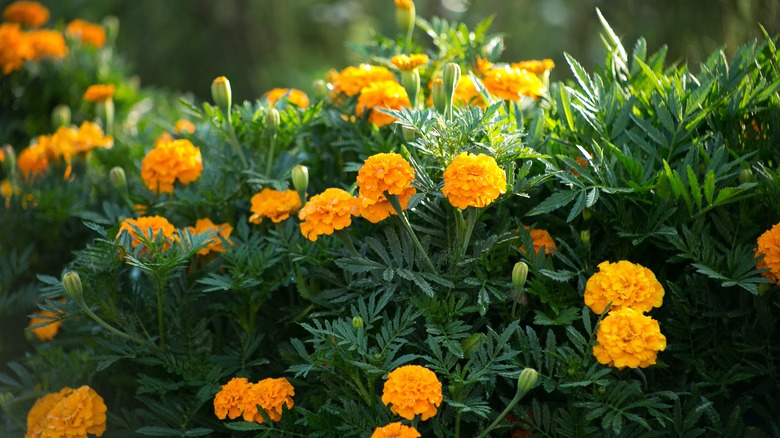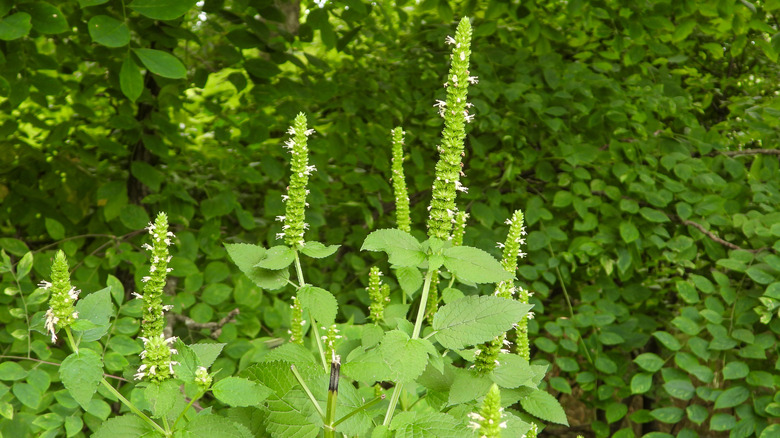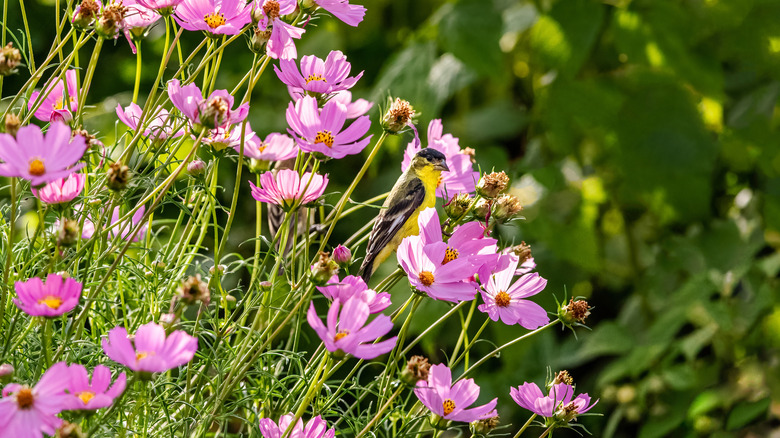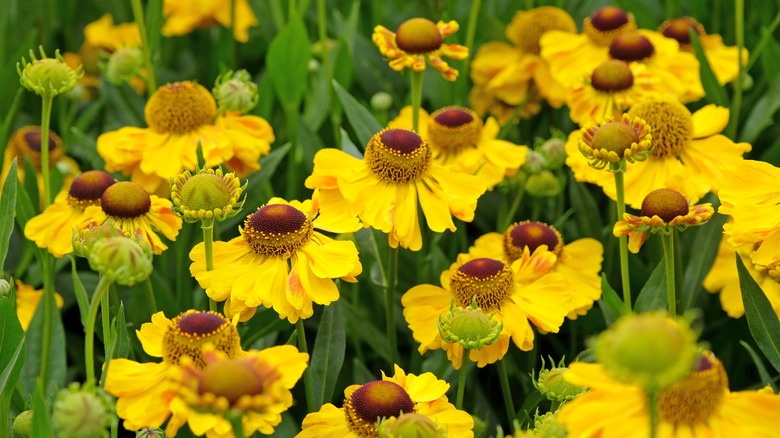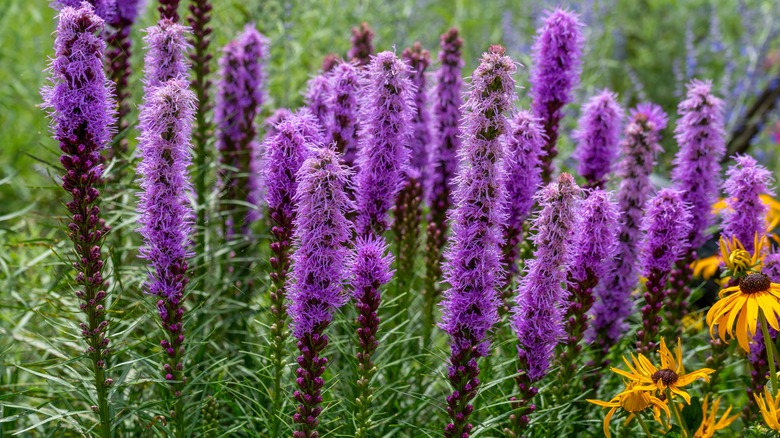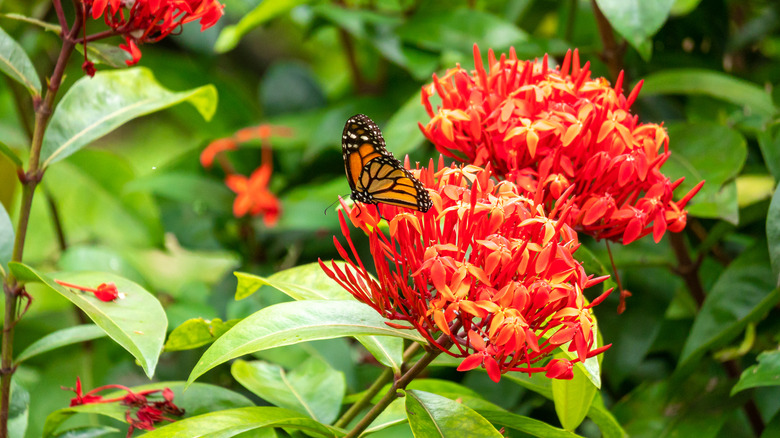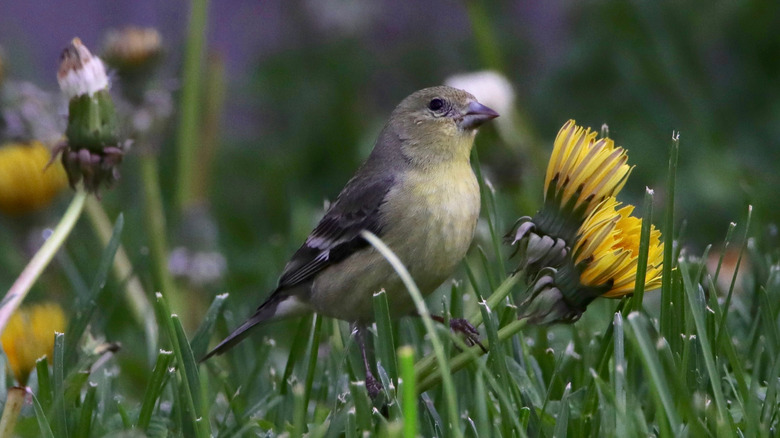13 Plants That Will Have Goldfinches Flocking To Your Yard In No Time
American goldfinches (Spinus tristis) can be entertaining to watch as they contort to pluck food from plants and do aerial somersaults. Their bright coloring also makes them attractive little flyers to lure to a yard. Males are brighter yellow with black on the tops of their heads and wings; females have duller yellow coloring and no black on their foreheads. They tend to congregate in weedy areas with some shrubs and trees for shelter but will flock to the outskirts of cities as well, especially when the types of foods they like are abundant there. What's their preference? While goldfinches will eat some insects in the summer, they usually feast on seeds. In fact, they love to nibble on seed-bearing flowers like zinnias, sunflowers, coneflowers, and asters, so planting them may indeed attract more goldfinches to your yard.
Not only do adult goldfinches seek seeds for their own nourishment, they readily feed them to their young. They tend to start the nesting process in July and August – later than some other species of birds — about the time that many of their favorite flowering plants are offering up the most nesting materials and tasty seeds to eat. If you're wondering exactly which ones might draw the most goldfinches to your garden, here's a list of 13 to consider planting.
1. Purple coneflowers
If you're looking for flowers likely to attract finches to your garden, don't forget the purple coneflowers (Echinacea purpurea). These wildflowers are favorites with goldfinches as well as pollinators like bees and butterflies. Part of the daisy family, these perennials grow well in zones 3 to 9. Be sure to leave the cone-shaped heads in place once the petals fall away from the blooms since that's where goldfinches frequenting your yard will glean the seeds. As a side benefit, any seeds not eaten by birds will produce more colorful flowering plants.
2. Sunflowers
While we often think of common sunflowers (Helianthus annuus) as being yellow, they come in several colors including orange, red, and maroon. More than the color, goldfinches are attracted to all the yummy seeds they hold in their large heads. Not all sunflower varieties produce seeds, however, so if feeding goldfinches is your goal be sure to pick one to suit your needs. You'll need a sunny area, as their name implies, and they do well in spots that offer some shelter from brisk breezes since they can get heavy and blow over easily as they mature.
3. Zinnias
Unlike some other favorites of goldfinches, zinnias (Zinnia elegans) are annuals, so they won't return year after year. They do produce seeds that can be sown the following year, but if you're planting zinnias to draw goldfinches, they may not leave too many behind after the summer is over. There are many different varieties of zinnias to choose from and colors range from purple and yellow to orange and pink. Keep in mind that frost is not their friend, so plant these colorful beauties after the cold weather has officially passed in your area.
4. Asters
If you're looking for a flowering plant that will grow from late summer right through fall, this is an another seed-filled option to consider. The most common varieties are the New England aster (Symphyotrichum novae-angliae) and the New York aster (Symphyotrichum novi-belgii). Hardy in zones 3 to 8, asters offer abundant flowers that can attract goldfinches to a yard. These plants do well in full sun in cooler climates but can't tolerate the midday heat in warmer areas. Mature plants in colors like pink, purple, red, and white purchased at garden centers make good landscaping options.
5. Poppies
Poppies (Papaver spp.) are often known for bright red blooms but they also come in orange, purple, and pink varieties. They bloom from late spring to early summer, then later in the season seeds will start shaking around within their pods. That's when goldfinches take an interest in them since they enjoy dining on those tiny black seeds inside. Poppies are hardy in zones 3 to 9 and do best when they get at least six hours of sun each day. They also like a nicely drained area that doesn't leave their roots standing in too much water.
6. Sedum
Sedum (Hylotelephium), also called stonecrop, is a type of succulent plant that will indeed attract goldfinches. It has clusters of star-shaped blooms in colors like orange, pink, red, and yellow that produce all the little seeds these birds crave. Be cautioned, however, that some gardeners report sedum is also a favorite for finches when it comes to munching on the leaves. That may end up being more of a curse than a blessing when attracting these little feathered friends and a point to keep in mind when selecting sedum for your flower beds in zones 3 to 10.
7. Marigolds
Marigolds (Tagetes) come in a variety of sizes and colors including orange, yellow, red, and multicolor. They'll bloom over and over again from spring through fall when planted in a sunny location. They attract all types of pollinators to your garden and goldfinches enjoy feeding on the seeds left behind after the blooms fade. As a side benefit, they have been known to turn away rabbits that might graze on other plants. For some people, the smell of growing marigolds can be a bit overpowering, though, so take that into consideration when deciding where to plant them.
8. Yellow giant hyssop
This native plant lives up to its name growing around 4 to 6 feet in height. The small yellow flowers it produces from July to September leave behind seeds that goldfinches love to pluck from spiky blooms. Yellow giant hyssop (Agastache nepetoides) thrives in partial or full sun and it can withstand both conditions that are somewhat dry or quite wet. If you've contemplated planting a butterfly garden and want to attract finches, too, this is a good plant to consider. It gets bonus points for being deer resistant since the leaves are bitter when eaten.
9. Cosmos
Sometimes called Mexican asters, cosmos (Cosmos bipinnatus) can grow quite tall – up to 6 feet. They have 3- to 5-inch flowers varying in hue from orange, yellow, and white to pink, red, and maroon. And, yes, the seeds left behind when these large blooms fade are quite attractive to goldfinches. Like sunflowers, these plants need shelter in windy areas to keep them from blowing over. One solution is staking them, but you can also bolster cosmos by planting them near sturdy fencing. Additionally, these flowers don't mind hot, dry conditions, making them perfect for warmer climates.
10. Sneezeweed
These perennials – also known as Helen's flower (for Helen of Troy) or bitterweed – are found blooming across North America from late summer through fall. It's not uncommon to see goldfinches perched among them eating their seeds. Related to daisies and asters, these multi-petaled yellow flowers grow best in at least partial sun, and soil that's moderately moist to wet. And despite its name, sneezeweed won't make you sneeze, but is toxic to mammals when ingested at high quantities. Sneezeweed (Helenium autumnale) pollen is transported by bugs from plant to plant rather than carried by the breeze.
11. Blazing star
Both marsh blazing star (Liatris spicata) and rough blazing star (Liatris aspera) may be ideal for finches looking for a seed snack. In fact, with marsh blazing star, they often perch on the tips of the spiky plants and can hang upside down while foraging. These flowering plants produce purple flowers all summer long offering pops of purple even when other flowers are fading. Hardy in zones 3 to 8, both like full sun, but marsh blazing star prefers soil wetter while rough blazing star can better withstand dry periods.
12. Milkweed
You may have heard that milkweed (Asclepias) attracts butterflies, but goldfinches are drawn to this perennial, too. Plant this colorful flower not only to feed goldfinches seeds, but to provide nesting material as well. There are several types of milkweed hardy in zones 3 to 9; they all require full sun and room to grow. Swamp milkweed (Asclepias incarnata) will thrive in wetter areas, but common milkweed (Asclepias syriaca), butterfly milkweed (Asclepias tuberosa), and showy milkweed (Asclepias speciosa) do best in soil with good drainage so keep that in mind if you give one of these varieties a go.
13. Dandelions
Homeowners usually try to eliminate common dandelion (Taraxacum officinale) as a non-native weed rather than encouraging it, but goldfinches love it. They eat dandelion seeds and use the hairy parts of the seed heads to build their nests. If you decide to set aside a spot to grow dandelions, you can harvest seeds from plants growing wild. In the spring or summer, sprinkle them over the soil and they'll easily take root. However, any uneaten seeds may be carried to other parts of your yard and garden and take over, so give that some thought before you get started.
